How to choose a split system for an apartment or a house: the best brands + recommendations for buyers
Since its appearance on the market, climate control technology has gained unprecedented popularity.And this is quite expected. After all, no fan can create such a comfortable microclimate even in a small apartment.
Since the niche of climate control equipment is actively developing and is annually replenished with hundreds of good units, before purchasing you need to understand in detail how to choose a split system for your apartment. Otherwise, you are buying a pig in a poke and will probably spend money on equipment that cannot cope with cooling your home.
To make it easier for you to choose the right solution for your apartment, in this article we looked at important criteria that should be taken into account when choosing climate control equipment. We have also provided a rating of the best manufacturers of split systems, whose products are of decent quality and reasonable price tags.
The content of the article:
Operating principle and features of split systems
With the introduction of innovative technologies into air conditioners, silent and high-tech devices are gradually replacing bulky old-style models.
At the same time, new devices are distinguished not only by their performance and an extensive range of functions, but also by their noiselessness and ease of operation.
How does climate control work?
It’s worth starting to get acquainted with climate control technology with theory. The main task of an air conditioner is to absorb heat from inside the building and remove it outside.
This is achieved due to the properties of liquid substances. They absorb heat as they evaporate and release it as they change from a gaseous to a liquid state.
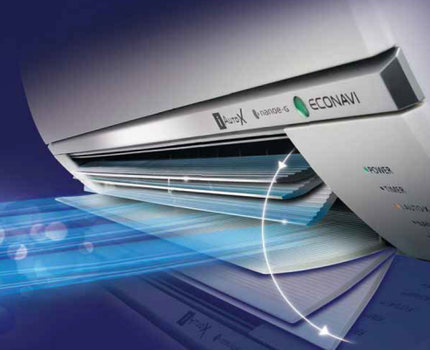
The task of this type of equipment is not to create pleasant coolness, but to absorb excess moisture. When purchasing, take this fact into account and order additionally humidifier. After all, low humidity can lead to various respiratory diseases.
Features of inverter models
The operation of inverter climate control equipment is controlled by a frequency-controlled motor. The motor converts electric current into direct current, and then again into alternating current.
Thanks to this idea, you can control the rotation speed of the compressor. Accordingly, the user has the opportunity to reduce/increase power.
Until the required temperature has been reached, the inverter motor operates at maximum power. As a result, the room cools or heats up much faster.
As soon as the desired temperature has been reached, the motor reduces speed, but does not stop. In this state, it can maintain a given microclimate without creating unnecessary noise. This significantly distinguishes it from a conventional split motor. We provided a detailed comparison of inverter and conventional split systems in this article.

The list of advantages of inverter air conditioners should be supplemented by their durability and reliability. This is explained by the fact that the compressor wears out the most when it is constantly turned on and off, as classic units do.
We recommend that you read top ten inverter split systems, based on popularity among buyers and positive reviews from the owners of these models.
Conditioner selection criteria
The main characteristics that you should pay attention to are performance and functionality. Also an important criterion is the operating temperature.
But most modern models operate in a wide range. Therefore, this factor is relevant only for extremely hot regions.
Power calculation depending on quadrature
Its effectiveness depends on the performance of climate control equipment. Therefore, before purchasing, you need to perform the calculations correctly.
After all, if you order an insufficiently powerful unit, it simply will not cope with maintaining the specified temperature. Well, an overly productive unit is a waste of money, since it will never work at full capacity.
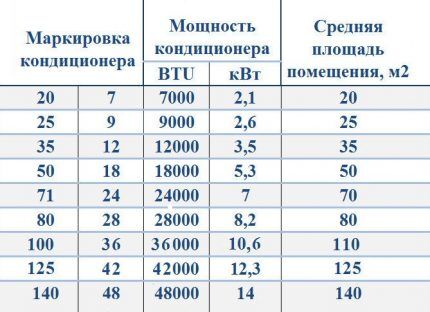
When calculating power, first of all, take into account the area of the room. The optimal choice would be 1 kW for every 10 square meters. After this, you need to add about 25% more to the obtained value. This will come in handy on a summer day when the sun shines into the room for half the day.
It is important to take into account the amount of heat-generating equipment in the room. If you are going to install climate control equipment in a kitchen or office where there are many computers, then feel free to increase the required performance by 30%.
The last factor to take into account when calculating is the number of people who are constantly in the room. If the device is purchased for home or office use, then about 100 W is required for 1 person.
But when the unit is installed in a gym or restaurant, increase the required power by 300 W.
We wrote in more detail about calculating the power of climate control equipment in next article.
If you don’t want to do the calculations, you can use ready-made solutions. So, for a room of 20 m22 the ideal choice would be “sevens”. Their capacity is 7,000 BTU. For 27 square meters, climate control equipment with a capacity of about 9,000 BTU is suitable.
Basic functionality of split systems
Today, air conditioners can work not only for cooling or heating. They can also be enabled in mode ventilation, or dehumidification.
The first function allows you to evenly distribute the air throughout the room. In this case, only the internal unit of the device works. This mode will be useful in winter, when heat accumulates only near the radiators.
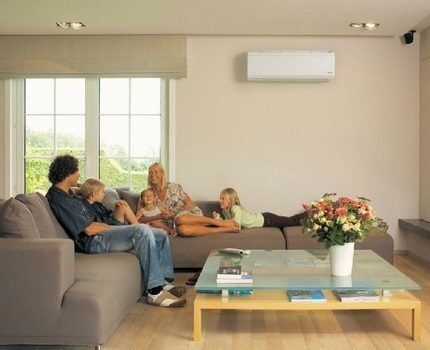
The function “Night mode" After turning it on, the climate control equipment reduces the fan speed as much as possible, which allows you to significantly reduce the noise emitted.
In this case, the temperature decreases/increases as smoothly as possible, over several hours.
If your budget allows, then order a split system that can operate in automatic mode. Its peculiarity is that the device monitors its operation using sensors.
That is, it automatically turns on the ventilation, heating or cooling mode to maintain an optimal microclimate in the room.
Types of climate control equipment
One of the most important technical characteristics of a split system is its power type. Based on this factor, the unit is classified into one of three categories: industrial, household or semi-industrial.
The latter are distinguished by high power. They can cool a room with an area of more than 100 square meters.
Household models are intended for home use. Their power rarely exceeds 7 kW. Therefore, the room they can serve should not be more than 50-60 m2.

Depending on the design, climate control equipment can be monoblock or may consist of two or more units.
The last type is the most common. As a rule, such units are a pair of blocks. One is located outside the room, and the other is inside.The components are connected using copper tubes and electrical cables.
Split systems, in turn, are divided into the following subcategories:
- wall;
- channel;
- cassette;
- columned;
- floor-ceiling;
- inverter
The main difference is the design of the indoor unit. Therefore, each of the presented types has its own advantages and disadvantages. Let's take a closer look at them.
Type #1 - wall-mounted split systems
Wall-mounted climate control equipment is the most common. This is due to its good performance and price, accessible to buyers with any income level.
This type of air conditioner consists of a pair of blocks. One of them should be installed in the room - under the ceiling and not far from the window opening. The external one is mounted slightly lower and from the outside of the building.
The list of advantages of wall-mounted units should also include their versatility. They can be installed in absolutely any premises. Be it an apartment, house, office or shop.
The only limitation is power. As a rule, this type of equipment has a power of no more than 10 kW. Therefore, it is only suitable for rooms with a total area of up to 100 m2.
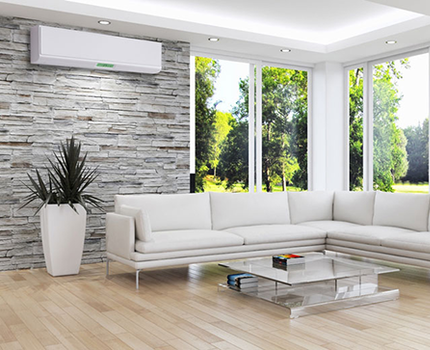
Type #2 - duct air conditioners for office and home
A distinctive feature of duct-type equipment is its installation behind a suspended ceiling. This allows you to hide all wires and copper pipes. The air in such a device is distributed evenly through a system of thermally insulated air ducts.
As a result, you get the opportunity to cool not just one, but several rooms at once.
The power of duct split systems varies from 5 to 25 kW. This performance will be more than enough to service an apartment with 5 rooms, a small office or a country house.
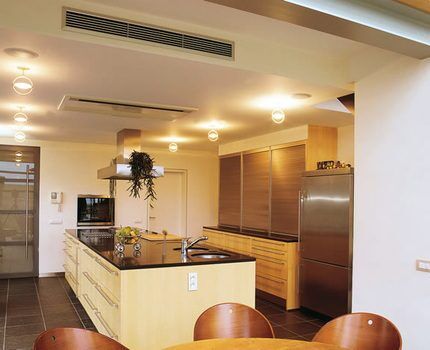
Type #3 - practical cassette split systems
Cassette climate control technology is an analogue of duct climate control technology. The only difference is that in the former, air enters the room through a special hole in the bottom of the block.
This compartment most often has a square shape - 600 x 600 mm. But if the device is highly productive, then the hole increases in length to 1200 mm.
The main advantage of this type of technology is its invisibility. Only the decorative grille will remain visible, which will not affect the aesthetics of the room.

Type #4 - column and floor-ceiling devices
Column models are most often used where the highest possible cooling capacity is required and design is not too important. They are distinguished by impressive dimensions and are mounted only on the floor.
Please take this fact into account when purchasing them. It is also not recommended to be near a working device - a strong flow of cold air will definitely not be good for your health.
You can replace cassette climate control equipment using floor-ceiling devices. This will be the best solution if the room does not have a suspended ceiling.
These types of units are characterized by a relatively shallow depth. For most models it varies from 180 to 250 mm.

Type #5 - window and mobile monoblocks
Both presented categories belong to the category of monoblock climate control equipment. They have only one block, which acts both as a condenser and as an evaporator.
Advantages of window air conditioners - ease of installation, relatively low price and hood function. It is because of these characteristics that this kind of monoblocks were popular in the past.
Today, demand for them is falling due to the high level of noise generated during operation and damage to thermal insulation. Therefore, only a few manufacturers on the market produce monoblock window units.
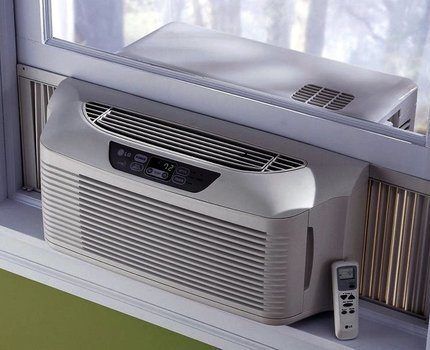
Mobile climate control equipment significantly stands out among its analogues. Its main feature is the ability to freely move the device around the room. All you need to do is lead the air duct through the window to the street.
Often the models presented above are supplemented with a set of filters.This allows you to freshen the air and significantly reduce the cleaning time in the room.
The advantages of such units include the absence of the need for installation, as well as portability. But be aware of the high price, noise and modest performance.
Separation of equipment by price
When figuring out how to choose the right split system for your home, you will come across devices in three price categories: premium, middle class and budget devices. Their difference lies not only in the amount indicated on the check. To understand the features, let's look at each category in more detail.
Premium models are the most expensive. Most split systems of this class are produced in Japan by high-tech companies.
As a rule, elite devices stand out from their analogues simply by their enormous functionality, unique design and quiet operation. But you will have to pay a good price for such conveniences.
The ideal choice for the average buyer would be middle class air conditioners. They are the embodiment of the ideal combination of price and technology. The largest range of household appliances of this class is produced in Japan and Europe.

In budget class Chinese and Korean companies occupy leading positions among manufacturers.
The main disadvantage of products in this segment is unpredictability. You never know how high-quality equipment you will come across.
At the same time, cheap air conditioners are much noisier, operate in a very limited temperature range, and they are not equipped with any protection system.
The best manufacturers of climate control equipment
The ease of use of the air conditioner, its functionality and, most importantly, reliability depend on the choice of supplier. To make it easier to decide, let's make a list of the best manufacturers.
Place #1 - sophisticated Daikin air conditioners
The company has been successfully operating in the market for more than four decades. During this time, Daikin has established itself as a supplier of multifunctional and high-quality household appliances. Its employees pay special attention to manufacturing technology, as well as after-sales service of the device.

The manufacturer presented above has recently become a market leader, offering customers a good range Daikin split systems. All brand products are of decent quality.
Therefore, when placing an order, you can count on the environmental friendliness of the device, its high quality and durability. But keep in mind that such a set of benefits will be expensive.
Place #2 - Mitsubishi semi-industrial equipment
Mitsubishi is in second place among companies producing household and semi-industrial climate control equipment. Most of the devices of this brand belong to the elite class, but the range also includes relatively inexpensive models. We recommend that you read rating of the best air conditioners brand.
If you decide to go with this brand, then pay attention to inverter units.As a rule, they are equipped with several automatic operating modes, as well as an ionizing air purification function.
Place #3 - perfect mid-range Toshiba
For those who want to save money, Toshiba produces air conditioners middle class. The company has been operating on the market for more than 120 years, and it was its engineers who created the first split system for a New York printing house.
The distinctive features of devices from this brand are reasonable prices, high reliability, and a huge range of functions. At the same time, most models are equipped with an inverter compressor, which allows you to save on electricity.
Place #4 - innovative Fujitsu split systems
The fourth place in the ranking was taken by the Japanese company Fujitsu. Her range full of semi-industrial and household air conditioners.
It is this company that is the first to introduce innovative developments, setting the trend in the climate control equipment market.
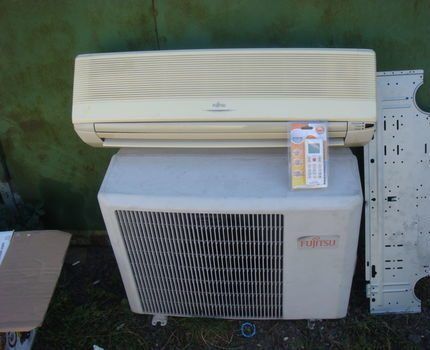
Place #5 - reliable Panasonic equipment
The last place in the TOP is occupied by another Japanese brand. Panasonic produces industrial split systems, as well as household models. With each new device, you can see how the company improves the quality of materials, increases manufacturability and increases the number of functions.
Present on the market Panasonic models all price categories. But if you can afford to spend a little more, then pay attention to split systems equipped with generators and air ionizers, as well as a catechin filtration system.
Video and useful video on the topic
The consultant shares tips on choosing climate control equipment:
Buying an air conditioner is always a long and scrupulous process. Especially for those who have never done this before.
But If you take into account all the above tips, correctly calculate the power and decide on the set of functions, you can get a device that will make the microclimate in your house or apartment truly comfortable.
Do you want to supplement the above material with advice on choosing or focus on the products of another worthy manufacturer, whose name we did not mention in this article? Write comments in the block below, express your opinion, and do not hesitate to ask questions to our experts.




For more than a year now, we have had a wall-mounted split system in our home, a very necessary piece of equipment. In the summer it cooled the air perfectly, a week ago I had to change the mode due to a change in the weather, now the system is heating. The night mode also justifies itself; the system is not particularly noisy at normal times, but at night it is almost inaudible. Then I bought it for almost 12 thousand hryvnia, now this model is already cheaper.
Indeed, now it is difficult to imagine your life without air conditioning. It is so comfortable with it that it is difficult to imagine life without this equipment. We rented an apartment and asked the owner to install air conditioning, but he did not agree to anything. Then they began to consider the option of a mobile floor air conditioner, but it also has its own characteristics and is not as convenient as it seems at first glance. Yes, and it stands like a wall-mounted one. But then the owner finally agreed and bought an inverter. It works quietly and cools well.